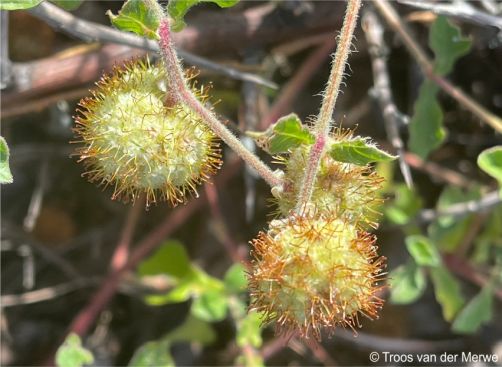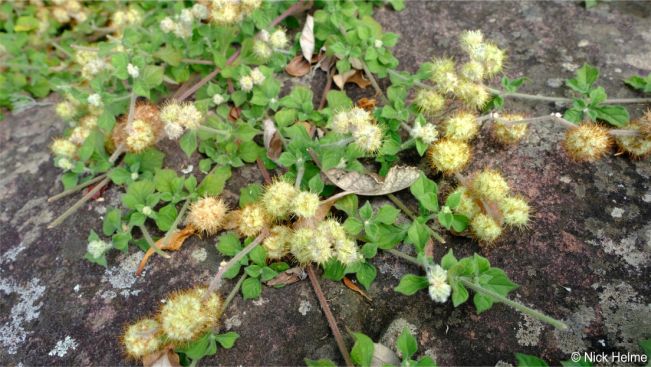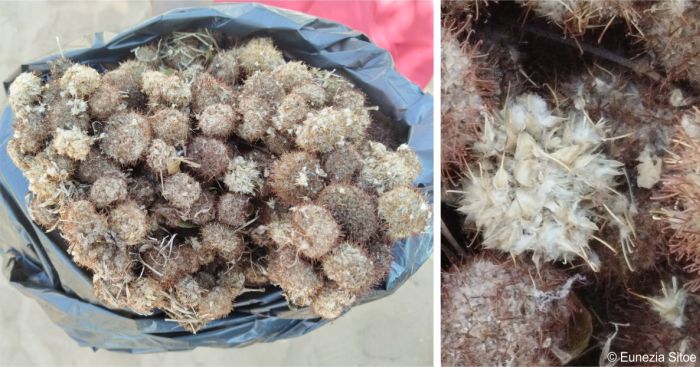Cyathula natalensis
Cyathula natalensis Sond.
Family: Amaranthaceae
Common names: Natal cyathula, KZN hookweed (Eng.); Natalserondeklits (Afr.); munamumuhulwane (Tshivenda); xinama, rinama (Xitsonga)
Introduction
A creeping herb cherished as a love charm in South Africa, as well as southern Mozambique by the Tsonga people. This herb’s sticky touch, thanks to its spiky hooks, makes it a key ingredient in crafting love potions.

Description
Description
Cyathula natalensis is an annual or perennial, much-branched herb, with an upright, scrambling or prostrate habit, growing up to 300 mm in height and spreading up to 1.4 m. Stems are slender and covered in short hairs. Leaves are oblong-spathulate, with a narrow base and a broad apex and at the broadest part it abruptly narrows to a pointed tip. Its flowers are grouped into dense, rounded heads, 10-15 mm in diameter when in flower. The flower head is made up of fertile and infertile flowers. The outer parts (perianth) of the infertile flowers, which don’t bear seeds, develop into stiff, hooked spines. The fertile flowers are pale greenish-white, with 5 petals, 5-6 mm long, covered with long, soft hairs. The flowering period is mid to late summer (December to March). The fruiting head is 15-30 mm in diameter including the spines, and very easily attaches itself and clings onto clothing and/or fur.

Conservation Status
Status
This species is not threatened, it is assessed as Least Concern (LC) by the Red List of South African Plants.
Distribution and habitat
Distribution description
This is a terrestrial plant found in sandy soils in open woodland or grassland, it is also found along roadsides and on disturbed lands from sea level to 1 100 m. It occurs in KwaZulu-Natal and Limpopo Provinces in South Africa, and in Mozambique and Zimbabwe.

Derivation of name and historical aspects
History
The genus name Cyathula means ‘litte cup’, from the Greek kyathos, meaning ‘cup’ plus diminutive. The stamens may be united into a membranous cup at the base. The species name natalensis means ‘of or from Natal’, now KwaZulu-Natal, a province of South Africa, where the type specimen was collected.
Ecology
Ecology
The fruiting heads have hooked bristles that grasp and cling to the fur of passing animals, and clothing of people. In this way they are dispersed. They can also cause problems for domestic animals, forming mats in their tail hair and/or woolly coats.

Uses
Use
Cyathula natalensis serves both decorative and medicinal purposes. Its ornamental appeal is complemented by its reputation for therapeutic benefits. It is used for medicinal and magical purposes by the Venda people. According to Hutchings et al. (1996) a combination of Trichilia emetica and Cyathula natalensis is used to treat leprosy, and women also use this combination as a general cosmetic oil. It has also been reported to alleviate fever, headaches, and a range of other health concerns.
Growing Cyathula natalensis
Grow
Cyathulas can be propagated by seed or cuttings. Soak the seeds for a day and sow in a warm, sunny place such as a heated bed, plastic tunnel or cold frame to maintain the warmth overnight. Seeds will germinate within a few days of sowing. Plants can be propagated by soft-tip cuttings placed in the mist-unit with bottom heat, and rooting should occur in 10-14 days.
References
- Helme, N. 2021-04. Observation of Cyathula natalensis, Lesheba Wilderness Reserve, Limpopo. iNaturalist. Online. https://www.inaturalist.org/observations/74818806.
- Hutchings, A., Scott, A.H., Lewis, G. & Cunningham, A.B. 1996. Zulu medicinal plants: an inventory. University of Natal Press, Pietermaritzburg.
- Jackson, W.P.U. 1990. Origins and meanings of names of South African plant genera. University of Cape Town.
- Magwede, K., Van Wyk, B.-E., & Van Wyk, A.E. 2019. An inventory of Vhavenda useful plants. South African Journal of Botany 122: 57–58.
- Nichols, G. 2005. Growing rare plants: a practical handbook on propagating the threatened plants of southern Africa. Southern African Botanical Diversity Network Report No. 36.
- Plants of the World Online. Cyathula natalensis Sond. https://powo.science.kew.org/taxon/urn:lsid:ipni.org:names:60174-1. Accessed 2024/06/27.
- Raimondo, D., Von Staden, L., Foden, W., Victor, J.E., Helme, N.A., Turner, R.C., Kamundi, D.A. & Manyama, P.A. (eds) 2009. Red list of South African plants. Strelitzia 25. South African National Biodiversity Institute, Pretoria.
- Retief, E. & Herman, P.P.J. 1997. Plants of the northern provinces of South Africa: keys and diagnostic characters. Strelitzia 6. National Botanical Institute, Pretoria.
- Smith, C.A. 1966. Common names of South African plants. Memoirs of the Botanical Survey of South Africa No. 35. Government Printer, Pretoria.
- South African National Biodiversity Institute (SANBI), Biodiversity Advisor. Cyathula natalensis Sond. https://biodiversityadvisor.sanbi.org search. Accessed 2024/06/03.
- Townsend, C.C. 1988. Amaranthacae. Flora Zambesiaca 9(1):28–133. Accessed via JSTOR Gobal Plants https://plants.jstor.org.
- Van der Merwe, T. 2022-04. Observation of Cyathula natalensis, Vhembe District, Limpopo. iNaturalist. Online. https://www.inaturalist.org/observations/111293896.
Credits
Eunezia Sitoe, CREW
and Alice Notten, Kirstenbosch National Botanical Garden
July 2024
Acknowledgements: Troos van der Merwe and Nick Helme are thanked for providing images.
Plant Attributes:
Plant Type: Perennial, Scrambler
SA Distribution: KwaZulu-Natal, Limpopo
Soil type: Sandy, Loam
Flowering season: Early Summer, Late Summer
PH:
Flower colour: Green, White
Aspect: Full Sun, Morning Sun (Semi Shade), Afternoon Sun (Semi Shade)
Gardening skill: Average
Special Features:
Horticultural zones








Rate this article
Article well written and informative
Rate this plant
Is this an interesting plant?
Login to add your Comment
Back to topNot registered yet? Click here to register.